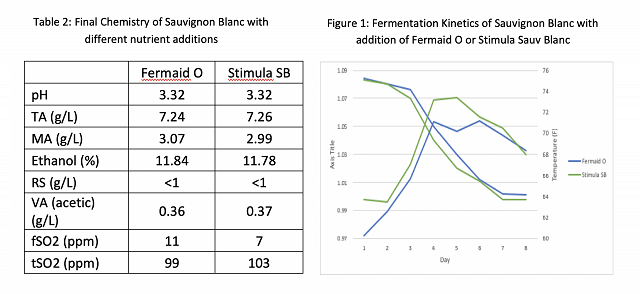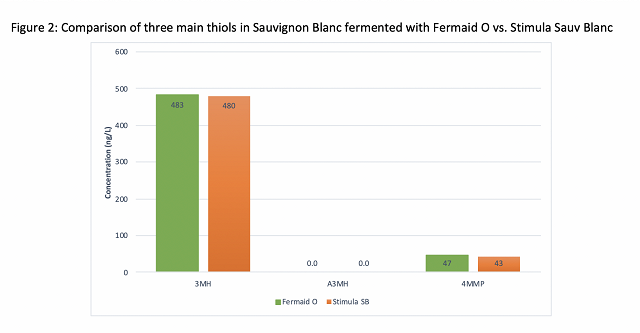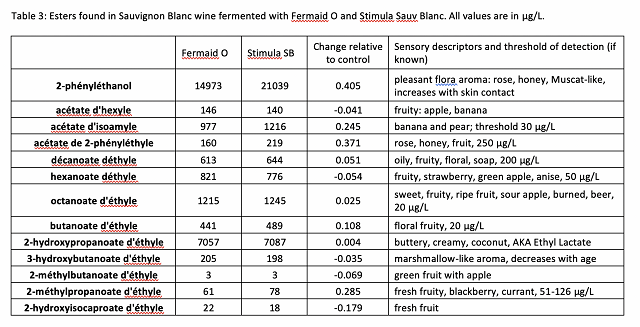The effect of Stimula Sauv Blanc (Scottlabs) fermentation nutrients on Thiol Production in Sauvignon Blanc (2018)
Rachel Stinson Vrooman
Stinson Vineyards
Summary
Thiols have become a defining characteristic of aromatic Sauvignon Blanc wines. Enological companies have developed specialized nutrients to increase thiol production during fermentation. In this study, fermentation using Stimula Sauv Blanc, a yeast nutrient specialized for thiol production is compared to fermentation using Fermaid O, a non-specialized yeast nutrient. Resulting wines had very similar general chemistry and thiol content. Triangle difference testing concluded the wines were different, however scores for thiol intensity were not significantly different between wines. Some fruity and floral esters were higher in the wine produced using Stimula Sauv Blanc.
Introduction
Grassy, bell pepper, box tree, broom, grapefruit and passionfruit are all descriptors used for the varietal character of Sauvignon Blanc. The chemicals that are responsible for this varietal character, 4MMP, 3MH and 3MHA have been described by Tominaga et al (1998). These chemicals are not present in grape juice, but rather precursors are transformed during the course of fermentation by yeast cells (Pinu et al 2012). The production of thiols requires that precursors are available in the fermentation and can be transported into yeast cells. Yeast cells must also have the cellular machinery to perform the transformation. As the base of knowledge surrounding production of aromatic thiols in Sauvignon Blanc (and other aromatic wines) has grown, so has interest in the mechanisms that convert precursors into aromatic compounds and how these can be used to maximize expression of thiols in the wine.
Yeast nutrients are routinely added to fermenting must to augment nitrogen for yeast metabolism. Several enological companies now offer yeast nutrients specially formulated to enhance aromatics of the wine by supplying components to optimize yeast metabolism. Stimula Sauv Blanc from Scott Labs is formulated to “optimize the uptake of 3MH and 4MMP precursors” as well as “stimulate their conversion to thiols in the yeast”. Product information includes the recommendation to add these nutrients early in fermentation to avoid catabolite repression and increase transporter efficiency. This study compares thiol production and perception in Sauvignon Blanc treated with Stimula Sauv Blanc compared to Fermaid O, the standard nutrient used by the winery.
Methods
Grapes were harvested and processed according to the standard protocol of the winery with addition of nutrient the only difference between lots. One lot received 20 g/hL Fermaid O (8 ppm Nitrogen) while the other lot received 30 g/hL Stimula Sauv Blanc (12 ppm Nitrogen), as per manufacturer’s instructions. Nutrients were added one day after inoculation. All other aspects of winemaking remained the same. Briefly, fruit was lightly crushed without destemming and pressed to tank. Juice was cold settled and fined with Claril SP and Stab Micro M with racking in between. Fined juice was then racked to two separate but identical concrete eggs for fermentation. Juice was inoculated with 15 g/hL Zymaflore X5 (a thiol-releasing yeast) rehydrated in 20 g/hL Superstart Blanc. Prior to the onset of fermentation, 1.25 g/L tartaric acid, 0.4 g/L malic acid and 15 g/L sugar were added. Fermentations took place at cellar temperature (without cooling) and were monitored for brix and temperature daily. At the completion of fermentation 50 ppm SO2 was added. Wine was aged on lees with stirring with SO2 and pH monitoring.
Wines were tasted at a sensory session conducted in January 2019 by 30 winemakers and other production staff. No formal training was conducted, however informal standards of “bell pepper”, “passionfruit”, “grapefruit” and “boxwood” were provided. All samples were presented in clear glasses with random three-digit numbers. Three glasses were presented, each with 2 ounces of wine. Panelists were asked to identify which of the three wines was different (a triangle difference test), then to evaluate each wine for thiol intensity. To prevent the dumping effect, panelists were also given two opportunities to write their own descriptors, in conjunction with the triangle test and in a comment box at the bottom of the scoring sheet.
Results
Table 1 reports the initial juice chemistry after settling. Wine chemistry after fermentation was the same for both lots (Table 2). Fermentation kinetics were very similar, though the temperature in the Stimula Sauv Blanc treatment was several degrees warmer during days 4 and 5 (Figure 1).


The concentration of three main thiol compounds, 3MH, 3MHA and 4MMP were measured by NYSEOS in March of 2019 (Figure 2). Two of the three (3MH and 4MMP) were found above the sensory threshold of detection in both treatments, and in equal amounts between treatments. 3MHA was not detected in these samples. In a triangle test 18 out of 30 respondents were able to distinguish which wine was different. This is a significant difference (Z=3.11, p<0.001). There were no consistent patterns in descriptors given for the difference perceived. Fermaid O had a mean thiol intensity of 5.24 (SD=1.75) and Stimula Sauv Blanc had a mean thiol intensity of 4.65 (SD=1.54). These scores were not significantly different.
Esters were also analyzed by NSEOS in March of 2019 (Table 3). The wine fermented with Stimula Sauv Blanc had higher levels of esters in general, with notably higher amounts of esters contributing to pleasant floral aromas (2-phenylethanol).


Preliminary Conclusions
Wines produced from fermentation with Fermaid O and Stimula Sauv Blanc were different, however there were no large differences in thiol intensity or concentration. Wines produced with Stimula Sauv Blanc had higher levels of some fruity and floral esters which may have contributed to this difference.
References
Pinu, F. R., S. Jouanneau, L. Nicolau, R. C. Gardner, and S. G. Villas-Boas. (2012) “Concentrations of the Volatile Thiol 3-Mercaptohexanol in Sauvignon Blanc Wines: No Correlation with Juice Precursors.” American Journal of Enology and Viticulture 63, 3: 407–12.
Tominaga, T., A. Furrer, R. Henry, and D. Dubourdieu. (1998). Identification of new volatile thiols in the aroma of Vitis vinifera L. var. Sauvignon blanc wines. Flav. Frag. J. 13:159-162.
